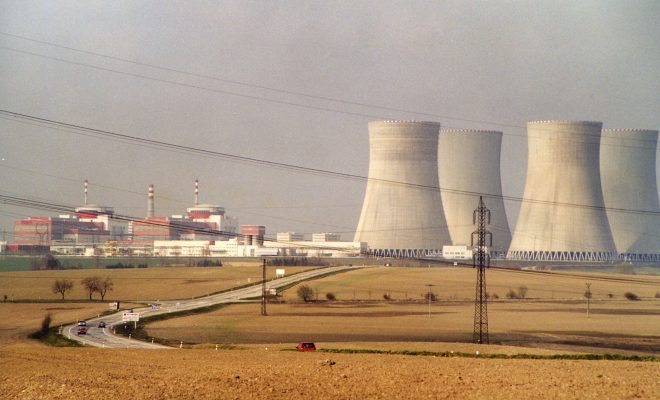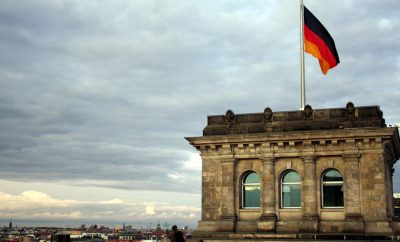 Image courtesy of [IAEA Imagebank via Flickr]
Image courtesy of [IAEA Imagebank via Flickr]
Energy & Environment
Nuclear Energy: Worth the Risk?
On Saturday May 9th a transformer fire broke out in New York. While this was a seemingly innocuous event, there was more to the incident than just a fire. It broke out at the site of a nuclear power plant, located only about 35 miles from Manhattan. While the fire never spread to the nuclear power plant itself and there was no immediate threat of a nuclear meltdown, the potential danger was concerning. Yet these risks are just part of the balancing act that is required to harness nuclear power for energy. Read on to learn about the development of nuclear energy, its risks, and its rewards.
History of Nuclear Power
Developing the Technology
The first notions of atoms can be traced all the way back to the ancient Greeks, who philosophized about tiny, unseen elements which combine to form the world around us. But the real work on nuclear energy essentially started in the early years of the 20th century. In the late 1930s, German scientists, following the previous example set by Italian physicist Enrico Fermi, bombarded uranium with neutron, causing it to split. The experiment and subsequent efforts revealed that during the fission process some mass is converted into energy.
In 1942, Fermi took the next step by achieving a self-sustaining chain reaction underneath the University of Chicago’s athletic stadium. This step effectively ushered in the nuclear age. During WWII this field was mainly focused on harnessing the power of the fission reaction into some type of weapon. However, following the war focus returned to producing energy from the reaction, as part of the Atomic Energy Commission created by Congress in 1946. The first reactor to produce electricity was in Idaho on December 20, 1951. The first nuclear powered plant that created power for public use in the United States was in Shippingport, Pennsylvania in 1957.
How do nuclear power plants work?
There are two types of nuclear power plants and they work in separate ways to generate power. In a pressurized water reactor, water is pressurized but not allowed to boil. The water is then streamed though pipes and turned in to steam which powers the generators. In this type of reactor, the water creating the steam and the water in the reactor do not mix.
The other type is known as a boiling water reactor. As the name implies, in this case the water is allowed to boil and turns into steam through fission. The steam, like in the pressurized reactors, turns the generators, which create electricity. In both systems, the water can also be reused once it has been reconverted from steam back into its liquid form.
The Nuclear Power Industry
Following the opening of the plant in Pennsylvania, the industry continued to grow rapidly throughout the 1960s as corporations across the U.S. saw the possibility of a power source that was viewed as a cheaper, safer, and more environmentally friendly than traditional sources, such as coal. However, this trend began to reverse in the 1970s and 80s as the popular opinion of nuclear power became negative and many of the strong selling points of nuclear energy became areas of concern.
Nevertheless, as of January 2015, 31 countries were operating 439 nuclear power plants worldwide, although the number of operating plants can fluctuate slightly based on different definitions of the term “operable.” The United States has the most plants at 99, almost twice as many as the next country France, which has 58. The plants themselves are located predominately in what are commonly considered the more developed countries. One of the major explanations for this phenomenon are the high costs required to build a nuclear power plant. Another major factor in the peaceful use of nuclear power is the Nuclear Non-Proliferation Treaty or NPT.
Nuclear Non-Proliferation Treaty
The Nuclear Non-Proliferation Treaty (NPT) has been one of bedrocks for peacefully spreading, and at times hampering, the spread of nuclear power worldwide. The first step can probably be traced back to a speech given by President Dwight Eisenhower. This speech, coined the “Atoms for Peace” speech, provided a blueprint for effectively managing nuclear proliferation following WWII. It also paved the way for spreading nuclear technology in a positive way.
While many of the suggested measures from Eisenhower’s speech were not taken, the International Atomic Energy Agency was born out of his ideas. This agency provided the prospect of nuclear knowledge in exchange for agreeing to safeguards and arms limits. While it worked in some cases, it could not halt the military aspect of nuclear research. It did however help give rise to the NPT.
The NPT divided countries into the proverbial nuclear weapon haves and have nots. Its requirements were also essentially the same, in return for allowing inspections countries were giving technical knowhow. While there are many criticisms levied against the NPT, it did work to prevent the spread of nuclear weapons, while helping some nations gain nuclear power as an energy source.
A Series of Unfortunate Events
Despite all the efforts made to safeguard nuclear energy, there are still many concerns over the safety of nuclear power plants. This danger has manifested itself several times over the course of the nuclear power age, both internationally and abroad.
The worst nuclear power plant disaster in history was in Chernobyl, Ukraine which was then part of the Soviet Union. During the disaster, 50 people were killed at the plant and as many as a million more were exposed to the radiation. The amount of radioactive fallout released into the air, as a result, was 400 times more than what had been released in the bomb that was dropped on Hiroshima in 1945.
Domestically, the worst nuclear energy disaster was the Three Mile Island incident in 1979. During the crisis on an island in Pennsylvania, a full nuclear meltdown was narrowly avoided and no one was killed. Nonetheless, the stigma created from the ordeal was a key contributing factor to the decline of new nuclear plants in the U.S. during the 1970s and 80s.
The most recent disaster came in 2011 in Fukushima, Japan. During this disaster a massive earthquake, followed by a tsunami, damaged the nuclear reactors in Fukushima. This led to a nuclear meltdown that killed as many as 1000 people trying to evacuate the area.
These are just three examples, but there are more, both in the U.S. and abroad. While nuclear energy has been lauded for its sustainability and limited impact on the environment, the threat of a nuclear meltdown is a major consideration in regards to expanding the technology going forward.
The Future of Nuclear Energy
With last week’s fire at a nuclear facility rekindling fears over the dangers of nuclear technology, what exactly is the future of nuclear energy both domestically and abroad? In answering that, two aspects need to be considered, namely nuclear waste and security.
Waste
Although nuclear energy is often touted as a clean alternative to other energy sources, such as coal and natural gas, it has its own waste issues. In the U.S. alone each year approximately 2000 metric tons of high-level radioactive waste are generated. Troublingly, there is no permanent repository for this nuclear waste so it remains stored on site, potentially vulnerable to attack and leakage.
The waste issue continues further down the supply chain as well. The mining of uranium, which occurs mostly outside of the U.S. and therefore also partly nullifies any argument in relation to energy independence, is a very harrowing experience. A number of chemicals are used to mine Uranium which poison both the surrounding environment and the workers involved in the extraction.
Security
Along with waste is the issue of security. It has already been shown that the security of a nuclear power plant can be jeopardized by human error and natural disasters. However after 9/11 there have been fears of a terrorist attack on a nuclear facility. While the nuclear plants are supposedly protected by measures designed by the Nuclear Regulatory Commission (NRC), there are acknowledged vulnerabilities.
Air and sea attacks could be problematic, as well as multiple coordinated attacks on a facility at once. Spent nuclear rods are particularly vulnerable to attack as they sit outside of controlled nuclear reactors. While the NRC has made strides in some of these categories, especially in regards to potential air strikes, concerns remain that it still falls short in other categories such as potential land and sea assaults. Furthermore, force on force tests–staged attacks on nuclear plants–showed at least 5 percent of plants are still not adequately protected even after changes were made to increase protection following 9/11.
These fears include other worries that stem from the Soviet collapse of the early 90s. These are centered on what are termed as “loose nukes”– unaccounted nuclear weapons from the Soviet Union. Similar concerns may also arise as civil wars continue in countries such as Iraq or Syria who at one time were known to be pursuing nuclear weapons.
Staying the course?
Coupled with waste and security concerns are also cost considerations. Nuclear power plants are very expensive to maintain and suffer a failure rate, in regards to financing, of over 50 percent, meaning tax payers are often required to bail them out. In light of all these considerations and with other truer sustainable energy sources it would seem the days of nuclear energy would be numbered.
This assumption is wrong however, as already 70 new plants are under construction with 400 more proposed worldwide. While many of these will never leave the drawing table, the rise in construction and planning of new nuclear plants points to nuclear power’s proven track record in at least one regard–battling CO2 emissions and producing power on a scale that currently far exceeds any other renewable options.
This option is particularly attractive to countries with state-run governments that can commit to long term investments and are desperate to move beyond major polluters such as coal-power plants, such as China. Meanwhile in Western democracies while some construction is planned, many are working toward phasing out nuclear power altogether. In this regard Germany is leading the pack and has pledged to be completely nuclear free by 2022. The following video explores the future of nuclear power:
Conclusion
Nuclear energy seems to be the ultimate compromise. While it is cleaner than coal or gas plants, it still produces radioactive waste that has no long term storage location and takes thousands of years to decay. Conversely it has a proven track record and while it may cost more to build new nuclear facilities than any other energy source, the energy produced far outpaces many alternatives. Thus, the world with its ever growing energy demands is left to maintain the delicate balance. We are still in the nuclear age, although how long we’ll stay here remains uncertain.
Resources
Primary
Department of Energy: The History of Nuclear Energy
Additional
United States History: International Atomic Energy Agency
Physicians for Social Responsibility: Dirty, Dangerous and Expensive The Truth About Nuclear Power
CNN: After Explosion at Nuclear Plant, Concerns of Environmental Damage
Duke Energy: How Do Nuclear Plants Work?
European Nuclear Society: Nuclear Power Plants Worldwide
Arms Control Association: Arms Control Today
Foreign Policy: Think Again Nuclear Proliferation
CNBC: 11 Nuclear Meltdowns and Disasters
World Nuclear Association: Fukushima Accident
Union of Concerned Scientists: Nuclear Plant Security
BBC News: Nuclear power Energy for the Future or Relic of the Past?








Comments